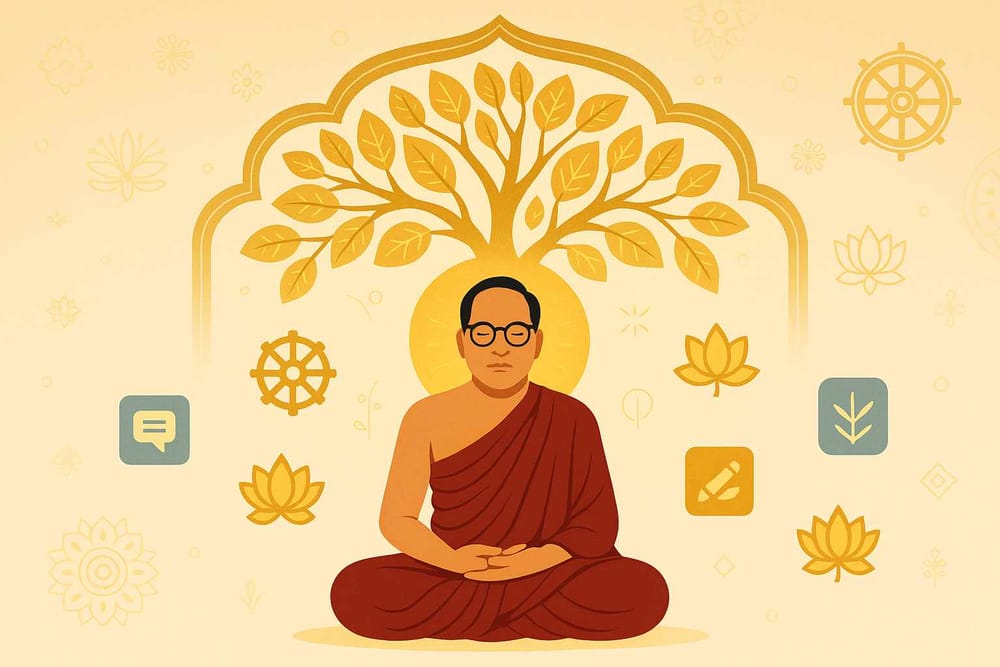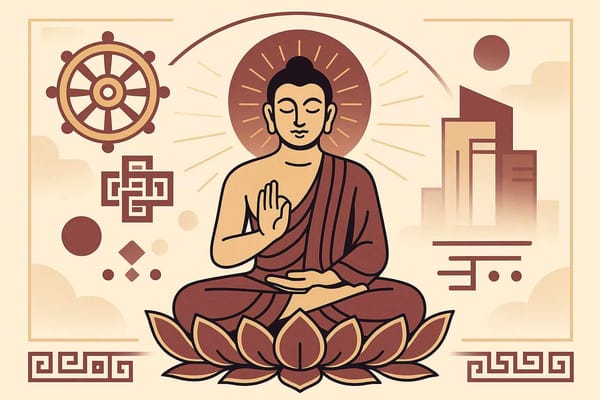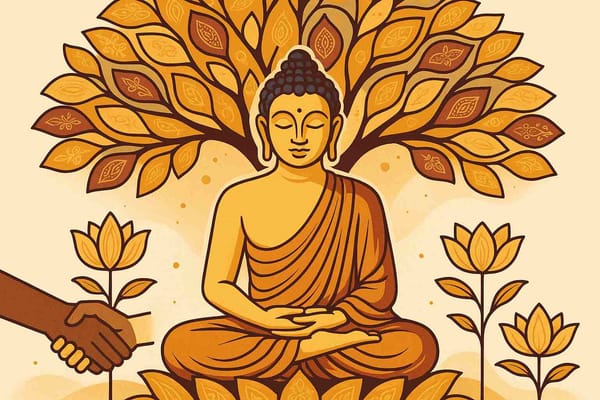
Exploring the Roots and Philosophy of Navayana Buddhism- A 2025 Guide
Have you ever thought about spirituality not just as a path to inner peace, but as a powerful force for social change? In the vast and diverse landscape of Indian beliefs, there exists a stream of thought that is both deeply compassionate and fiercely revolutionary. This is the story of Navayana Buddhism, or the "New Vehicle," a path carved out by the great Dr. B.R. Ambedkar, not just for personal enlightenment, but for the liberation of millions.
It's a journey that challenges us to see faith through the lens of justice, equality, and human dignity. Let’s walk this path together and understand the heart of this transformative movement.
A New Dawn: The Historical Moment that Birthed Navayana
To truly understand Navayana, we must travel back to a pivotal moment in India's history. Imagine the air thick with anticipation in Nagpur on October 14, 1956. Dr. B.R. Ambedkar, the chief architect of our Constitution and a man who had lived through the crushing weight of caste discrimination, stood before a sea of faces. With him, nearly half a million of his followers were about to make a profound choice.
This wasn't just a religious conversion; it was a powerful declaration of freedom. It was a mass rejection of a system that had denied them basic human dignity for centuries. Dr. Ambedkar had spent years studying the world's religions, searching for a spiritual home that did not just tolerate but celebrated equality. He found his answer in the teachings of the Buddha, but with a renewed purpose for the modern world.
He saw the caste system, which is deeply woven into the fabric of Indian culture and traditions, as a source of immense suffering. For him, a spiritual path had to address this worldly suffering head-on. This historic event in Nagpur marked the birth of Navayana, offering a new hope and a renewed sense of self-worth to countless people.
The Heart of Navayana: A Philosophy for This World
So, what makes Navayana Buddhism so different from the paths of Theravāda or Mahāyāna? Dr. Ambedkar wasn’t just adopting an ancient faith; he was re-interpreting it to address the urgent needs of society. He saw Buddhism as a rational, ethical, and socially engaged philosophy.
Navayana is built on a foundation of reason and social conscience. It shifts the focus from metaphysical concepts like karma and rebirth to the immediate reality of human relationships and social structures. Dr. Ambedkar argued that the concepts of karma and rebirth were often used to justify the caste hierarchy, suggesting one's birth was a result of past actions. He rejected this, putting forward a vision of Buddhism that empowers individuals to change their circumstances in this life.
The philosophy of this "New Vehicle" can be understood through three core pillars that Dr. Ambedkar emphasised:
- Pragya (Wisdom): This isn't just about understanding scriptures. It's about developing a critical consciousness to see and understand the social systems that create inequality. It’s the wisdom to question, to analyse, and to seek the truth about our society.
- Karuna (Compassion): This is the deep, empathetic feeling for the suffering of others. In Navayana, Karuna is not passive pity; it is an active force that drives one to work towards alleviating the pain caused by injustice and discrimination.
- Samata (Equality): This is the ultimate goal. Samata is the vision of a society where every individual is treated with equal respect and dignity, regardless of their birth or background. It is the bedrock of a just and humane world.
How is Navayana Different from Traditional Buddhist Schools?
This is a question many people have, and the distinction is crucial. While traditional Buddhism often focuses on individual liberation from the cycle of samsara (birth, death, and rebirth), Navayana channels its energy towards collective liberation from social oppression.
It radically re-interprets some foundational Buddhist ideas. For instance, the Four Noble Truths are seen not just as truths about individual suffering, but as a framework for understanding and ending societal suffering caused by inequality. Meditation is valued not just for inner peace, but as a tool to build mental strength for the social struggle. In essence, Navayana takes the Buddha's timeless teachings on compassion and ethics and applies them directly to the fight for social justice.
Exploring these different interpretations can be a profound experience. The quest for knowledge, whether through ancient texts or modern reinterpretations, is a vital part of any spiritual journey. For those interested in delving deeper into the path of knowledge within Hindu scriptures and practices, understanding these diverse philosophies provides a richer context.
Symbols and Practices: A Living Tradition
Navayana is not a philosophy confined to books; it is a vibrant, living culture with its own powerful symbols and practices that unite the community.
- The 22 Vows: During the historic conversion, Dr. Ambedkar administered 22 vows to his followers. These vows are a powerful affirmation of the new path, involving the rejection of certain Hindu deities and caste-based practices, and the embrace of Buddhist principles of equality and non-violence.
- The Ashoka Chakra: This wheel, which is also at the center of our national flag, is a central symbol for Navayana Buddhists. It represents Dhamma (righteousness) and the continuous movement towards a just and progressive society.
- Celebrations of Community: Festivals like Dhammachakra Pravartan Din (celebrating the day of the mass conversion) and Buddha Purnima are not just religious events. They are moments of solidarity, reflection, and a reaffirmation of the community's commitment to the path of equality.
Dr. Ambedkar’s magnum opus, The Buddha and His Dhamma, serves as the principal guide for Navayana practitioners, laying out his rational and humane interpretation of the Buddha’s teachings.
The Enduring Relevance of Navayana Today
In a world still grappling with injustice, discrimination, and inequality, the message of Navayana Buddhism is more relevant than ever. It provides a spiritual framework that champions democratic values, liberty, and fraternity.
It appeals to a new generation that seeks a spiritual path grounded in reason, ethics, and social action rather than dogma and ritual. Its principles resonate far beyond the issue of caste in India, inspiring movements for gender equality, racial justice, and human rights across the globe.
Navayana Buddhism stands as a powerful testament to the idea that faith can be a force for radical good in the world. It reminds us that true spirituality is not about escaping the world, but about transforming it for the better.
Understanding these diverse and profound spiritual movements is a journey in itself. At Bhaktilipi, we are dedicated to sharing these timeless stories and philosophies in a way that connects with modern readers. If you feel inspired to explore the rich tapestry of devotion and wisdom, we invite you to explore our platform.
A Legacy of Hope and Action
Navayana Buddhism is more than a religion; it is a movement, a call to action, and a legacy of hope. Dr. B.R. Ambedkar’s vision created a path where spirituality and the struggle for justice walk hand in hand. It teaches us that compassion without action is incomplete, and that the truest form of devotion is to work towards a world where every human being can live with dignity.
As this "New Vehicle" continues its journey, it carries with it a powerful message for all of humanity: the path to liberation is one we must walk together, by uplifting one another.
A passionate group of people dedicated to preserving India's knowledge of Dharma, Karma, and Bhakti for ourselves and the world 🙏.
Comments
Related in

Exploring the Navayana - Buddhism's Modern Path
In our hearts, many of us carry a quiet longing—a desire for a spiritual path that doesn’t ask us to leave our minds at the door. We seek a faith that speaks not only of inner peace but also of justice and dignity in the world around us.

Navayana Buddhism- Explores a New Perspective
In the vast tapestry of Indian spirituality, faith is often a legacy we inherit, a path our ancestors walked. But sometimes, faith becomes a choice—a powerful, conscious decision to forge a new path. It becomes a statement, a revolution. This is the story of Navayana Buddhism, the "New

Exploring Spiritual Heritage-Navayana and Iconic Temples in Faridabad
Sometimes, we think we know a city. We see the tall buildings, the busy roads, the rush of daily life, and we assume that’s the whole story. I used to think of Faridabad that way – a bustling industrial hub, a close cousin to Delhi. But beneath this modern surface,
